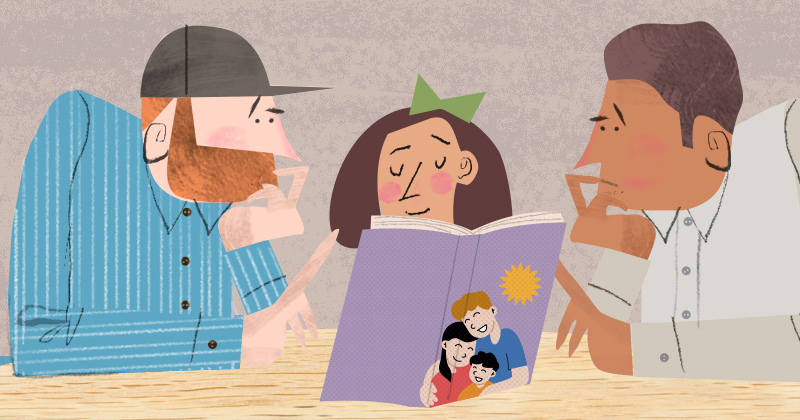Depictions of Fatherhood

UD researchers find ‘narrow’ depictions of fatherhood in children’s literature
When children read picture books, they are often greeted with depictions of family and life lessons their young minds soak up. What happens then, when those depictions don’t offer a thoughtful image of gender or family as they have changed over the years? That is one of the questions University of Delaware Professor Bill Lewis and Social Science Research Analyst and UD alumna Laura Cutler explored in their recent paper, published in the quarterly journal Children’s Literature in Education.
In “Portraits of Fatherhood: Depictions of Fathers and Father–Child Relationships in Award-Winning Children’s Literature,” Lewis and Cutler looked at more than 80 children’s books to analyze how authors and publishers depicted fathers and fatherhood.
What they found was that over a span of nearly 20 years, from 2001 to 2020, these books presented “a narrow view of fatherhood,” both in what roles fathers have in familial units and which types of fathers are presented. They also noted that these portrayals have remained relatively static over the last two decades.
Lewis, a professor in the College of Education and Human Development’s School of Education, breaks down what spurred the research and what he and Cutler hope changes as a result of the research.
Why did you and Cutler look into depictions of fatherhood in children’s literature?
Lewis: One of the things that Laura and I agree on is that literature is a social and moral laboratory. It allows readers to safely experiment with choices and to see other families that are different from their own, see other kids. It allows us to see multiple ways of being. We wanted to do this research, in particular, because we’re both interested in gender and in the way that gender is portrayed in these books. However, we were also concerned that many books relied on narrow and traditional portrayals of parental characters, providing children a limited number of gendered roles and choices.

Bill Lewis, professor in the School of Education at the University of Delaware
What books were studied as part of this research?
Lewis: We limited ourselves to award-winning children’s books from 2001 to 2020. We looked at the Caldecott Medal and Honor Awards for those years because the Caldecott is arguably the most prestigious children’s literature award, and the books are considered to be of the highest quality. Even though the Caldecott is usually given for the illustrations, the reward has a huge impact on the buying of those books. School libraries buy them, parents buy them.
However, even though they’re high-quality books, we didn’t really see the kind of changes that we would think that we’d be seeing, particularly because the roles of fathers have changed so substantially over the last 40 years.
What were some of the things that you saw from your research when looking at these books?
Lewis: We had originally identified 89 books. However, more than half of the books had to be removed, because only 46% of the books actually included a readily identifiable father. That’s a really important finding in and of itself. There were not a lot of fathers to be found. Eventually, we got down to 38 books that had identifiable fathers and could be considered children’s picture books.
What is the impact of not seeing readily identifiable fathers/father figures?
Lewis: Especially with younger children who are not necessarily reading conventionally, shared book reading experiences with their families are so important. It’s where they’re going to be able to see a variety of different kinds of families and a variety of different family compositions, and they are going to be paying attention to the roles that adult characters play in those books.
When you don’t see fathers involved, it reinforces a lesser role for fathers overall in the family. It reinforces a negative — and maybe more traditional — idea that fathers are out of the picture, not really involved in childcare. All those kinds of things can be very harmful, particularly when we know how important it is for the changing expectations for fathers to play a bigger role in their children’s care.
What other observations did you make?
Lewis: The other issue that we saw is that when we looked at the books that had readily identifiable fathers, most of them were white and in heterosexual pairings. We didn’t see a lot of fathers of color represented in these books or queer fathers. That’s a super problematic finding because over the 20 years that we sampled our books from, our society has become more culturally diverse and we have a lot more same sex and single parent homes. However, in this set of award-winning books what we see are basically white heterosexual parents.
It was a surprise to see how little we saw fathers of color represented in these books. And the other thing is, when Black fathers were depicted or immigrant fathers were depicted, it was either always about slavery or always about civil rights, so always about the struggle. Don’t get me wrong — these books are important. However, where’s that Black dad who is just having a good time with their kid? It’s not just about struggle and overcoming all these obstacles. It’s also about active dads of color taking an active role in their children’s lives.
What would you tell parents/libraries purchasing children’s books and publishers/authors producing children’s books in light of your research?
Lewis: We would really like to see books where fathers are taking a much more active role in their children’s lives. In a lot of these books that had identifiable fathers, they were only briefly or just minimally shown, appearing in only one or two illustrations. What we would really like to encourage publishers to do is to show fathers in a variety of roles, particularly in that caregiving role.
Additionally, we want to see a wider variety of fathers. Fathers who are single. Fathers who are gay. We’d love to see all of those things.
Lewis noted that by showing children the expansive role fathers can play in the caregiving of their children, it tackles traditional gender roles for young girls and boys. One such book he says does a wonderful job of showcasing an active father is Interrupting Chicken by David Ezra Stein.
To learn more about CEHD research in literacy and language, visit its research page.
Read this story in UDaily.
Article by Marina Jones. Illustration by Jeffrey C. Chase. Photo by Kathy F. Atkinson.
Image caption: In a recent study, Professor Bill Lewis found that over a span of nearly 20 years, from 2001 to 2020, award-winning children’s books presented “a narrow view of fatherhood,” both in what roles fathers have in familial units and which types of fathers are presented.



